
TNU Journal of Science and Technology
229(06): 230 - 237
http://jst.tnu.edu.vn 230 Email: jst@tnu.edu.vn
UTILISING PET PLASTIC AND GLASS WASTE IN MANUFACTURING
OF MASONRY BRICKS
Ho Viet Thang*, Nguyen Trong Cuong, Le Thi Thom, Vo Trung Kien,
Ho Van Quan, Nguyen Thi Minh Xuan
University of Science and Technology - The University of Danang
ARTICLE INFO
ABSTRACT
Received:
02/4/2024
Nowadays, the manufacturing process of burnt clay masonry bricks
causes serious environmental pollution such as loss of agricultural land,
climate change. Besides, PET plastic and glass waste also cause serious
problems for the environment. Therefore, we reuse PET plastic and
glass waste to produce masonry bricks aiming to minimize the
environmental harm caused by burnt clay bricks and these wastes.
Different PET plastic/glass mass ratios are performed to produce
masonry bricks. The brick samples are evaluated for bulk density,
compressive strength, bending strength, water absorption and compared
with burnt clay brick samples. The results show that the bulk density,
compressive strength, and bending strength of brick samples made
from PET plastic and glass waste are higher than those of burnt clay
brick samples, while water absorption is much smaller than that of
burnt clay brick samples. The best brick sample in this study is the M37
sample with a compressive strength of 33.9 MPa which is 3 times
higher than the burnt clay brick samples.
Revised:
31/5/2024
Published:
31/5/2024
KEYWORDS
PET plastic waste
Glass waste
Masonry brick
Environment
CO2
NGHIÊN CỨU SẢN XUẤT GẠCH XÂY DỰNG SỬ DỤNG NHỰA PET
VÀ THỦY TINH PHẾ THẢI
Hồ Viết Thắng*, Nguyễn Trọng Cường, Lê Thị Thơm, Võ Trung Kiên,
Hồ Văn Quân, Nguyễn Thị Minh Xuân
Trường Đại học Bách khoa - Đại học Đà Nẵng
THÔNG TIN BÀI BÁO
TÓM TẮT
Ngày nhận bài:
02/4/2024
Ngày nay, quá trình sản xuất gạch xây dựng bằng đất sét nung gây ô
nhiễm môi trường nghiêm trọng như mất đất nông nghiệp, biến đổi khí
hậu. Bên cạnh đó, chất thải nhựa PET và thủy tinh cũng gây ra những
vấn đề nghiêm trọng cho môi trường. Vì vậy, chúng tôi tái sử dụng
nhựa PET và thủy tinh phế thải để sản xuất gạch xây dựng nhằm giảm
thiểu tác hại đến môi trường do gạch đất sét nung và các chất thải này
gây ra. Các tỷ lệ nhựa/thủy tinh khác nhau được khảo sát để sản xuất
gạch xây dựng. Các mẫu gạch này được đánh giá về khối lượng thể tích,
cường độ nén, cường độ uốn, độ hút nước và so sánh với các mẫu gạch
đất sét nung. Kết quả cho thấy khối lượng thể tích, cường độ nén, cường
độ uốn của các mẫu gạch làm từ nhựa PET và thủy tinh phế thải cao
hơn mẫu gạch đất sét nung, trong khi đó độ hút nước nhỏ hơn nhiều so
với mẫu gạch đất sét nung. Mẫu gạch tốt nhất trong nghiên cứu này là
mẫu gạch M37 có cường độ chịu nén 33,9 MPa cao gấp 3 lần so với
mẫu gạch đất sét nung.
Ngày hoàn thiện:
31/5/2024
Ngày đăng:
31/5/2024
TỪ KHÓA
Nhựa PET phế thải
Thủy tinh phế thải
Gạch xây dựng
Môi trường
CO2
DOI: https://doi.org/10.34238/tnu-jst.10015
* Corresponding author. Email: hvthang@dut.udn.vn

TNU Journal of Science and Technology
229(06): 230 - 237
http://jst.tnu.edu.vn 231 Email: jst@tnu.edu.vn
1. Introduction
In order to promptly meet the strong socioeconomic development and increase in population,
the construction of infrastructure is increasing accordingly. This is also the reason that motivates
the rapid development of the construction materials industry in general and masonry bricks in
particular. However, masonry bricks have been mainly produced by burnt clay. This
manufacturing process causes serious problems with environmental pollution from the loss of
agricultural land to the pollution of the gaseous environment because the bricks are burnt by
using mainly coal. It is estimated that to produce one billion burnt clay bricks, it consumes about
1.5 million m3 of clay, 150 thousand tons of coal and emits about 0.57 million tons of CO2 and
SO2 [1]. Therefore, in recent years, the State has promoted the production of unburnt masonry
bricks in order to reduce environmental pollution caused by burnt clay brick manufacturing
process. Although unburnt masonry bricks have reduced environmental harm due to the reduction
in the use of clay and coal, the production of unburnt bricks still causes environmental pollution
because the main raw materials used in this current process are cement and natural sand.
According to calculations, for each ton of cement production, 0.8-0.9 tons of CO2 are emitted into
the environment [2]. Sand or crushed stone used in the production of unburnt bricks also has
harmful impacts on the environment because sand mining generates deep holes, changes the
direction of riverbed flow and results in massive whirlpools. This causes a significant effect on
the river bank.
In addition to the fact that the earth is increasingly warming due to CO2 emissions from
human activities, the unsustainable production of building materials is a depletion of natural
resources without additional sources. Also, the rapid proliferation of solid waste and
inappropriate disposal of solid waste are increasingly causing problems for the environment.
Among solid wastes, PET plastic and glass wastes have been causing great harm to the
environment. According to a report by the Organization for Economic Co-operation and
Development, the world used 460 million tons of plastic in 2021, almost double that recorded in
2000. Along with that, the amount of plastic waste released more than doubled during that time to
353 million tons. However, only 9% of plastic waste was recycled, 19% was destroyed and
nearly 50% was buried in qualified garbage pits. Still 22% of plastic waste was disposed of in
improper landfills, burned in open landfills or leaked into the environment [3].
Besides plastic waste, glass waste is also increasing rapidly and this waste is difficult to
decompose. The natural decomposition of glass wastes can take millions of years because they
are non-biodegradable. Therefore, glass waste is now mostly landfilled. This will give rise to a lot
of risks to the environment as well as human safety.
Therefore, recycling glass and plastic waste is an urgent task. This is not only a work that
saves resources and energy but also minimizes environmental harm aiming to to preserve our
earth's environment secure. One of the effective approaches is to reuse PET plastic and glass
waste in manufacturing construction materials. For example, PET plastic and glass wastes were
reused to replace aggregate in the production of concrete and to produce building bricks [4] - [9].
Due to the posed practical challenges and requirements, we conduct research on
manufacturing construction materials reusing PET plastic and glass waste in this study. The
technical characteristics of the brick samples are evaluated for bulk density, bending strength,
compressive strength and water absorption in order to ensure the requirements of technical
standards for masonry bricks. On the basis of these results, we propose an appropriate approach
to produce building bricks from PET plastic and glass waste. This study also contributes to
reducing environmental pollution caused by plastic and glass waste as well as current
construction brick production methods.

TNU Journal of Science and Technology
229(06): 230 - 237
http://jst.tnu.edu.vn 232 Email: jst@tnu.edu.vn
2. Materials and Methods
2.1. Materials
2.1.1. PET plastic waste
PET plastic waste is collected from different sources such as mineral water bottles, soft drink
bottles, coffee cups.... then washed and dried. Next, the PET plastic waste is shredded to a small
size to facilitate the experimental process when melting plastic, the plastic samples after this
treatment are shown in Figure 1.
Figure 1. PET plastic waste after shredding
2.1.2. Glass waste
The glass waste used in this study was collected from waste glass bottles or at residential glass
processing factories, and then the glass was washed and dried. These glass bottles are then
crushed with a wheel mill, the particle size selected for this study is in the range of 0.14 mm ÷ 5
mm according to TCVN 7570:2006 [10], as shown in Figure 2 and Figure 3.
Figure 2. Glass waste after sanitizing and grinding
Figure 3. Glass waste after sieving
2.2. Methods
2.2.1. Mould casting
In this study, we moulded brick samples in a mould with dimension of length width hight
= (190 90 45) mm [11]. The brick moulding process is shown in Figure 4. In particular, the
dried PET waste plastic was put into the pan and heated until the PET waste plastic melted.
Continuous stirring was required to keep the plastic melted homogeneously during this process.
The dried glass particles were immediately added to the pan when all the plastics were melted.
To ensure the mixture was homogeneous, we stirred continuously. After the waste glass and
melted plastic were mixed homogeneously, these mixed materials were placed in the prepared
brick mould.

TNU Journal of Science and Technology
229(06): 230 - 237
http://jst.tnu.edu.vn 233 Email: jst@tnu.edu.vn
Figure 4. The process flow chart of producing masonry bricks from PET plastic and glass waste
Brick samples are cast with different PET plastic:glass mass ratios of 20:80; 30:70; 40:60 and
50:50. In order to compare the technical characteristics of bricks produced from PET plastic and
glass waste, we also investigated these technical characteristics with burnt clay bricks. The
investigated brick samples in this study are denoted as shown in Table 1.
Table 1. Notation of investigated brick samples
No
PET plastic:glass ratio
Notation
1
20:80
M28
2
30:70
M37
3
40:60
M46
4
50:50
M55
5
Burnt clay bricks
Mđc
2.2.2. Determination of bulk density
The bulk density of brick samples was evaluated according to TCVN 6355-5:2009 [12]
procedures. The bulk density of bricks sample, ρv (g/cm3) was evaluated according to the formula (1):
ρv=m
l.b.h (1)
where m is the mass of brick samples after drying, (g);
l, b, h is the length, width, and height of the brick sample, respectively, (cm).
Bulk density results are the average value of 5 test samples with an accuracy of 0.01 (g/cm3).
2.2.3. Determination of water absorption
Water absorption was conducted under TCVN 6355-4:2009 [13] protocols. Water absorption
of brick samples, H (%) is calculated by formula (2):
H = m1
m0
.100 (%) (2)
where m0 is the mass of the dried samples to constant mass, (g);
m1 is the mass of the samples in a water-saturated state, (g).
The water absorption results are the average value of 5 test samples with an accuracy of
up to 0.l%.
2.2.4. Determination of compressive strength
The compressive strength of brick samples was evaluated according to TCVN 6355-2:2009
[14] procedures. The compressive strength of brick samples, Rn (MPa) is calculated by the
formula (3):

TNU Journal of Science and Technology
229(06): 230 - 237
http://jst.tnu.edu.vn 234 Email: jst@tnu.edu.vn
Rn= K. P
S (3)
Where P is the load up to failure sample, (N).
S is the average area of the two compressive surfaces of the sample, (mm2).
K is the conversion factor. The compressive strength results are the average value of 5 test
samples with an accuracy of 0.1%.
2.2.5. Bending strength
Bending strength of brick samples was carried out according to TCVN 6355-3:2009 [15]
procedures. The bending strength of brick samples, Ru (MPa) is calculated by the formula (4):
Ru=3.P.l
2.b.h2 (4)
where P is the load at the fracture point, (N);
l is the length of the support span, (mm);
b, h is the width, height of samples, respectively, (mm);
The bending strength results are the average value of 5 test samples with an accuracy of 0.1%.
3. Results and Discussions
3.1. Dimensions and visible defects
Brick samples made from PET plastic and glass waste are checked for dimensions and visible
defects. Measurements show that the bricks had no serious visible defects. The deviation in
dimensions (length width height) is smaller than 2 mm. The representative brick samples are
shown in Figure 5. This result demonstrates that in terms of dimension and visible defects, the
appearance of brick samples meets the requirement of construction bricks according to Vietnam
standards TCVN 6477: 2016 [16].
Figure 5. Brick samples are manufactured from PET plastic and glass waste
3.2. Particle size distribution of crushed glass waste
Figure 6. Particle size distribution curve of glass waste after grinding and sieving


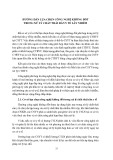

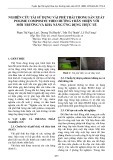
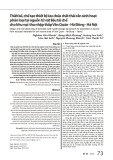

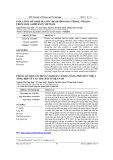
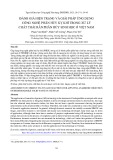
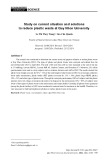


![Tài liệu Vi sinh vật môi trường [Mới nhất]](https://cdn.tailieu.vn/images/document/thumbnail/2025/20251123/ngkimxuyen/135x160/21891763953413.jpg)
![Sổ tay truyền thông Phân loại chất thải rắn sinh hoạt trên địa bàn tỉnh Quảng Nam [Chuẩn nhất]](https://cdn.tailieu.vn/images/document/thumbnail/2025/20251114/kimphuong1001/135x160/1701763094001.jpg)

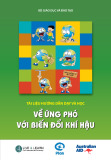
![Quản lý chất thải nguy hại: Sổ tay Môi trường [Chuẩn nhất]](https://cdn.tailieu.vn/images/document/thumbnail/2025/20251029/kimphuong1001/135x160/9011761720170.jpg)









